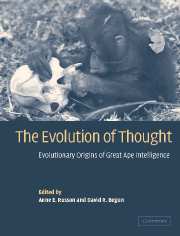Book contents
- Frontmatter
- Contents
- List of Contributors
- Preface
- 1 Evolutionary reconstructions of great ape intelligence
- 2 Enhanced cognitive capacity as a contingent fact of hominid phylogeny
- PART I COGNITION IN LIVING GREAT APES
- PART II MODERN GREAT APE ADAPTATION
- Introduction
- 7 What's in a brain? The question of a distinctive brain anatomy in great apes
- 8 Life histories and the evolution of large brain size in great apes
- 9 Evolution of complex feeding techniques in primates: is this the origin of great ape intelligence?
- 10 The special demands of great ape locomotion and posture
- 11 Great ape social systems
- 12 Diet and foraging of the great apes: ecological constraints on their social organizations and implications for their divergence
- PART III FOSSIL GREAT APE ADAPTATIONS
- Part IV INTEGRATION
- Author index
- Species index
- Subject index
8 - Life histories and the evolution of large brain size in great apes
Published online by Cambridge University Press: 20 August 2009
- Frontmatter
- Contents
- List of Contributors
- Preface
- 1 Evolutionary reconstructions of great ape intelligence
- 2 Enhanced cognitive capacity as a contingent fact of hominid phylogeny
- PART I COGNITION IN LIVING GREAT APES
- PART II MODERN GREAT APE ADAPTATION
- Introduction
- 7 What's in a brain? The question of a distinctive brain anatomy in great apes
- 8 Life histories and the evolution of large brain size in great apes
- 9 Evolution of complex feeding techniques in primates: is this the origin of great ape intelligence?
- 10 The special demands of great ape locomotion and posture
- 11 Great ape social systems
- 12 Diet and foraging of the great apes: ecological constraints on their social organizations and implications for their divergence
- PART III FOSSIL GREAT APE ADAPTATIONS
- Part IV INTEGRATION
- Author index
- Species index
- Subject index
Summary
INTRODUCTION
Our preoccupation with large brain size and why it evolved originally arose from interest in the evolution of traits that we consider to be special in our own species. Humans are generally thought to be more intelligent, behaviorally flexible, and culturally complex than other primate species. In humans, these complex behaviors are usually linked to the relatively large brain size that is also a key feature of Homo sapiens. Understanding the evolution of large brains may therefore help us to understand the evolution of complex behaviors and abilities. This requires identifying the costs and benefits of large brain size, in order to explain why large brains evolved in a few primate taxa but not in most, or in other mammal groups.
Compared to other mammals, haplorhine primates also have large brains (relative to body size), the relative brain size of humans is still larger, and those of the great apes are not exceptional within the group (Figure 8.1). However, a range of studies has found that the intellectual capacities of the great apes are significantly different from those of other haplorhine primates (e.g., Byrne 1995, 1999a; Russon, Bard & Parker 1996; and Blake, Chapter 5, Byrne, Chapter 3, Parker, Chapter 4, Russon, Chapter 6, this volume). This suggests that a large brain size relative to body size is not the only factor that may be important in determining levels of intelligence in primates.
- Type
- Chapter
- Information
- The Evolution of ThoughtEvolutionary Origins of Great Ape Intelligence, pp. 122 - 139Publisher: Cambridge University PressPrint publication year: 2004
- 7
- Cited by



